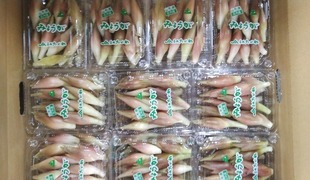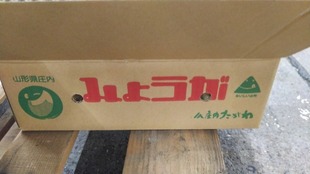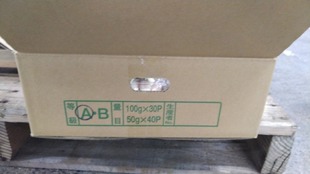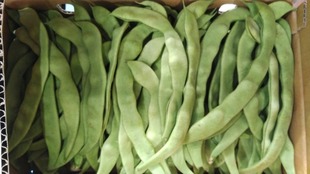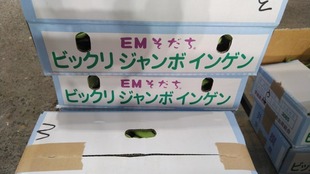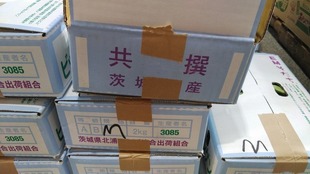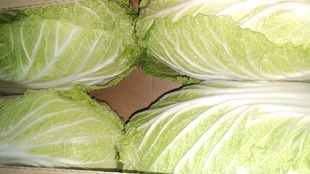Princess Himiko ≒ 魏志倭人伝→襄荷
【Product name】
japanese zinger
【Type】
Zingiber mioga (Thunb.) Roscoe
【Producing area】
Part of Tsuruoka City, Yamagata Prefecture (former Atsumi Town, former Fujishima Town, former Haguro Town, former Kushihiki Town, former Asahi Village), Shonai Town, Higashitagawa District (former Amarume Town, former Tachikawa Town), Mikawa Town (JA Shonai Tagawa, Delicious Yamagata)
【Origin of name】
The Buddha's disciple (one of the sixteen Arhats), Shuri Handoku Chula Pantaka, was very poorly remembered and sometimes even forgot his name. So I wrote my name and hung it around my neck. After his death, grass grew in the graveyard, so he named it 名荷; 茗荷.
【Major features】
The Shonai Town, Higashitagawa District election (Yamagata Prefecture) was announced on June 14, 2022 due to the expiration of the term of office, and 20 people will run for the fixed number of 14, 14 incumbents, and 6 newcomers will fight. By party, there are 1 communist, 19 independents, and 5 women. In the 2018 election for the same town, a total of 15 people, including 12 incumbents and 3 newcomers, ran for a fixed number of 16, and all of them were elected without voting. By party, there were 1 communist, 14 independents, and 2 women (parties at the time of the election). Voting will be on June 19th and will be counted on the same day. As of June 13, the number of registered voters is 17,532 (according to the Shonai Town Election Commission). A total of 20 people, 14 incumbents and 6 new faces, are preparing for the candidacy, and it is certain that the election contest will be held. Last time in 2018, only 15 people ran for the fixed number 16, and there was no vote due to "breaking the fixed number". In July 2021, Mikawa Town issued the local currency "Na(菜)no Ca" for the first time as a measure to stimulate consumption, which has been sluggish due to the spread of the new coronavirus infection. Repeatedly used by an unspecified number of people and business establishments in the form of banknotes. The full-scale introduction of local currencies issued by local governments is a rare case in Tohoku. 1 Na no Ca = 1 yen "Na no Ca" is issued by the town for 26 million yen, and the Dewa Chamber of Commerce and Industry Mikawa branch operates the business. A total of about 120 places, including restaurants and retail stores in the town, were expected to participate in the project. When shopping at participating business establishments after July 10, Nanoka was issued according to the payment amount, and a de facto discount was received. The grant ratio is 200 Na no Ca for every 500 yen (tax included) paid by restaurants, 500 Na no Ca for every 1500 yen for retail stores and service industries, and 1500 Na no Ca for every 5000 yen for the construction industry. The de facto discount rates were 40%, 33% and 30%, respectively. There are three types of banknotes: 200 Na no Ca, 500 Na no Ca, and 1500 Na no Ca. The name seems to be named after the town flower "rape blossoms". The Na no Ba received was available at any participating establishment. It was expected to be used in combination with cash because no change was made. The establishment could give Na no Ca again as change to another customer, and it seems that a certain amount could continue to circulate in the city. The expiration date was until February 27th (Sun) next year. Participating business establishments can redeem every Friday, and the final redemption date is set in early March of the same year. It seems that the town wants to be computerized in the future and become a permanent local currency. The Funds Settlement Law excluded gift certificates such as "local currency" issued by local governments. It seems that the Tohoku Local Finance Bureau cannot grasp the whole picture of the "local currency" issued by the local government. The person in charge of the town said, "It should be rare in the whole country for the local government to issue the local currency of banknotes in earnest. Unlike the point redemption of "QR code" payment and gift certificates, the mechanism that money continues to circulate in the town I wanted to make it." Shonai Plain, Yamagata Prefecture - It is nurtured by the flow of the mogami river and Akagawa river from different sources. To the north Mt. Chokai : Dewa Sanzan (Three Mountains of Dewa ; Shrine - Mt. Haguro, Mt. Gassan, Mt. Yudono) to the east - It is said that Koteko's son, Prince Hachiko, escaped from the capital at the discretion of Prince Umayado (Prince Shotoku), and became the founder of Dewa Sanzan (Three Sacred Mountains of Dewa) in Tsuruoka City, Yamagata Prefecture. South is surrounded by mountains in the Asahi mountain range(寒江山, 小朝日岳, 平岩山, 鳥原山, 祝瓶山 etc.)- One of Japan's leading granary areas, with large sand dunes on the west side facing the Sea of Japan. Humans settled in the Region as far back as the Paleolithic and Jomon periods. Southern hills and foothills : The ruins of hunting life at that time are interspersion. In the Kofun period, people also settle in the lowlands of the plains. He started his rice-growing life under the control of a powerful family. At the end of the Heian period, a manor called Oizumi-sho was set up in this region. “Gikeiki”, 大泉荘大梵寺を通せ給ふ - Description, Daibon-ji Temple later became known as Daiho-ji Temple.Eventually it will become the center of Oizumi-sho. At the beginning of the Kamakura period, Mr. Muto ruled as lord of a manorof Oizumi-sho. Since then, it has prospered as a regional center throughout the Middle Ages : In the 1530s, seeking harm during the war : Take up residence at Oura Castle (now Oyama). From the Middle Ages, Mt. Haguro was a major force here. It is said that he also served as a steward and protected Kurokawa thickly(Inherited for more than 500 years by the parishioner ; It is divided into an upper seat and a lower seat, which are Noza (farmer) of the guardian Kasuga Shrine. Oral biography of the 56th Emperor Seiwa. Designated in 1976 as a national important intangible folk cultural property.). After the fall, Shonai will be under the control of Echigo Uesugi. In 1591, Kanetsugu NAOE built Daihoji Castle as a political base. The Naoe army attacked the Yamagata Castle fiercely, and finally besieged the Hasedo Castle, the advance-guard station of the Yamagata Castle (the Battle of Dewa in the Keicho Era or the Battle of Hasedo-jo). As a result of the Battle of Sekigahara, Yoshiaki Mogami-Ko, the lord of Yamagata, ruled Shonai in 1601. Daihoji Castle is maintained as a retired castle: In 1603, the name was changed to Tsurugaoka Castle. Entering the Edo period, Mr. Mogami was confiscated in 1622.Instead, Tadakatsu Sakai(140,000 koku ; of rice in Fudai Daimyo)entered the country as the lord of the Shonai clan. The castle town is maintained with Tsuruoka as the residence -To build on the basics. The Shonai clan has Akumi District and Tagawa District. This is administratively divided into Kawakita Misato and Kawanami Five Streets. 中川通, 櫛引通, 京田通, 山浜通 - The Shonai clan was ruled by the Sakai clan for about 250 years. From the Restoration down to the present. In 1869, Mr. Sakai repatriates the edition.etc. “the great municipal mergers of the Heisei era” - 鶴岡市, 藤島町, 羽黒町, 櫛引町, 朝日村, 温海町が合併 - 平成17年10 月1日に, 新鶴岡市が発足 - With an area of 1,311.53 km2, it is the largest city in Tohoku. Formulated a comprehensive plan in January 2010. “藤沢周平(Mr. Tomeji KOSUGE)”, Born December 26, 1937. 旧東田川郡黄金村大字高坂 ; Section of village
Takasaka, Tsuruoka City- 暗殺の年輪, 1973 ;文藝春秋, 又蔵の火, 1974 ; 文藝春秋, 闇の梯子, 1974 ; 文藝春秋, 檻車墨河を渡る, 1975 ; 文藝春秋, 改題: 雲奔る 小説 / 雲井龍雄 ; 中公文庫, 竹光始末, 1976 ; 新潮文庫, 時雨のあと, 1976 ; 新潮文庫, 義民が駆ける, 1976 ; 中央公論社, 講談社文庫, 冤罪, 1976 ; 新潮文庫, 暁のひかり, 1976 ; 文春文庫, 逆軍の旗, 1976 ; 文春文庫, 喜多川歌麿女絵草紙, 1977 ; 講談社文庫,闇の穴, 1977 ; 新潮文庫, 闇の歯車, 1977 ; 講談社, 長門守の陰謀, 1978 ; 講談社文庫, 春秋山伏記, 1978 ; 家の光協会, 角川文庫, 一茶, 1978 ; 文藝春秋, 神隠し, 1979 ; 新潮文庫, 雪明かり, 1979 ; 講談社文庫, 回天の門, 1979 ; 文藝春秋, 驟り雨, 1980 ; 新潮文庫, 橋ものがたり, 1980 ; 新潮文庫, 出合茶屋 神谷玄次郎捕物控, 1980 ; 双葉社, 改題: 霧の果て, 1985 ; 文春文庫, 闇の傀儡師, 1980 ; 文藝春秋, 夜の橋, 1981 ;文春文庫, 時雨みち, 1981 ; 新潮文庫, 霜の朝,1981 ;新潮文庫,密謀,1982 ; 新潮文庫, よろずや平四郎活人剣, 1983 ; 文藝春秋, 龍を見た男, 1983 ; 新潮文庫, 海鳴り, 1984 ; 文藝春秋, “白き瓶-小説 / 長塚節”, 1985 ; 文藝春秋, 花のあと, 1985 ; 文春文庫, 風の果て, 1985 ; 文春文庫, 決闘の辻: 藤沢版新剣客伝, 1985 ; 講談社,潮田伝五郎置文, 1985 ; 東京文芸社, 本所しぐれ町物語, 1987 ; 新潮文庫, 蟬しぐれ, 1988 ; 文藝春秋, たそがれ清兵衛, 1988 ; 新潮文庫, 市塵, 1988 ; 講談社(日本歴史文学館), 麦屋町昼下がり, 1989 ; 文藝春秋, 三屋清左衛門残日録, 1989 ; 文藝春秋, 玄鳥, 1991 ; 文藝春秋, 天保悪党伝, 1992 ; 新潮文庫, 秘太刀馬の骨, 1992 ;文藝春秋, 夜消える,1994 ; 文春文庫, 日暮れ竹河岸, 1996 ; 文藝春秋, 漆の実のみのる国, 1997 ; 文藝春秋, 静かな木, 1998 ; 新潮社, 未刊行初期短篇, 2006; 文藝春秋- 鶴岡市青龍寺金峯, 高坂字大台, 滝沢字薬師嶽, “藤沢” 字荒沢: Designated date: April 23, 1941 - Management organization name: Tsuruoka City(S17・6/23) : Historic site scenic spot natural monument - 高さ約460m, 東には羽黒山, 月山, 湯殿山の翠を列ぬるあり北には鳥海山の巍峩たる雄姿を挺んづるあり西には日本海の渺茫たるあり其の北部には飛嶋の浮べるあり頂點竝高處よりの視界に入るもの更に舊庄内の田野大半遠く連なるあり最上の長川之を串流して海に注げるあり我邦展望の壯觀として洵に稀有に屬す山上に此の如き地點多く上中下位に依つて各々其の景觀を殊にす山亦佳林を帶び其の中幽致に富める地尠からず. “鶴岡市青龍寺” - 銅造如意輪観音坐像: Prefectural designated cultural property October 25, 1955-金峯山博物館. 六所神社の獅子頭6面 : Prefectural designated tangible folk cultural property December 1, 1998. 鶴岡市教育委員会(馬場町)2002 “鶴ヶ岡城跡確認調査報告書 二の丸御角櫓跡地点” 鶴岡市埋蔵文化財調査報告書19 : 地域ルネッサンス公園整備事業遺跡 : 城館, 古代 (細分不明) 時代, 須恵器, 赤焼土器, 城館, 中世 (細分不明) 時代, 土坑, 珠洲系陶器(壺擂鉢), 越前甕, 青磁, 瀬戸(梅鉢, 皿), かわらけ, 城館, 近世(細分不明) 時代, 土塁, 二の丸外堀, 唐津(皿, 擂鉢), 肥前染付(椀, 瓶), 大堀相馬, 瓦器, 瓦, 木製品, 石製品. “Shonai Town, Higashitagawa District“, With the enforcement of the town and village system in 1889, it became Amarume Village, Goshari Village, Yamato Village, Izaai Village, Sakae Village, Karigawa Village and Tachiyazawa Village. Furthermore, in 1890, Yaezato Village was separated from Goshari Village, and in 1891, Goshari Village was renamed Joman Village, and Kiyokawa Village was separated from Karigawa Village. Amarume Village enforced the town system in 1918, Karigawa Village enforced the town system in 1937, and on October 1, 1954, 1 town and 2 villages of Tachiyazawa Village, Kiyokawa Village and Karigawa Town merged with Tachikawa Town, became. In the same year, on December 1, 1956, Amarume Town, Yamato Village, Izaai Village, Sakae Village, Joman Village, and Yaezato Village merged into Amarume Town, and on January 1, 1956, Amarume Town. The two villages of Senbonsugi and Kuwata were separated from each other and incorporated into Tachikawa Town. Then, on July 1, 2005, Amarume Town and Tachikawa Town merged to form Shonai Town. The town is located in the northwestern part of Yamagata prefecture, from the southeastern part to the center of the Shonai Plain. A long north-south terrain along the clear stream Tachiyazawa River, which has the summit of Mt. Gassan, and the Mogami River, one of the three major rapids in Japan. It borders Sakata City to the north and northwest, Tozawa Village to the east, Okura Village to the southeast, Tsuruoka City to the southwest, and Mikawa Town across the Mogami River. It is a turning point connecting the regions and a gateway to the Shonai region. The climate is generally oceanic and relatively warm, but in winter the closer to the south (Moonyama side), the heavier the snowfall, the stronger the monsoon from the northwestern part (Sea of Japan side), and From spring to autumn, the strong winds in the east-southeast from the valley of the Mogami River are famous as “Kiyokawa-Dashi(It is counted as one of the three major local winds in Japan and is a representative example of isthmus winds. The Mogami River passes through the Mogami Gorge (a gorge with a width of about 1 km and a length of about 10 km that forms the saddle of the Dewa Hills).)”. It is about 22.2 km east-west, about 38.9 km north-south, and has an area of 249.17 km2, making it the 12th largest area in the prefecture. By region, forests account for about 62.9% and rice fields account for 22.8%. “Amarume Hachiman Shrine” : This shrine is located in Amarume, Shonai Town, and was founded in 719 when it was said that it solicited the spirit of Usa Hachimangu (Usa City, Oita Prefecture, Buzen Kuniichigu). It was the vassal of Mr. Fujiwara Oshu and the deity of Mr. Sato. In the Kamakura period, Minamoto no Yoritomo gave him the title of Amarume Hachimangu Shrine, and he was the general guardian of Amarume Township. It is said that the priest of Saigoku Fudasho solicited the sand from the Saigoku Fudasho (takes the sand home) and established it as the 33 Kannon sacred sites in the Shonai region. Reorganized in 1950, there are now 35 sacred sites across the five cities of Sakata, Tsuruoka, Yuza, Shonai, and Mikawa.) It was worshiped as one of Hachiman. In the Middle Ages, Mr. Anbo ruled the area around the area, and in 1362 he relocated Amarume Hachiman Shrine as the guardian shrine of his own building. For a long time after that, it was on the site of Mr. Anbo's mansion, but in the early modern period, 1637, he moved to the site for the first time in 260 years. The current Amarume Hachiman Shrine is an old building built in 1814, and it is said that it adopted the same ceremony as the Dewasanzan Shrine Sanjingo Shrine, and the worship hall and the main shrine are integrated and the palace is enshrined inside. The exterior of the hall of worship is the hip gable roof, thatched roof, 5 girders, a large staggered gable in front, and the eaves gable is used for the 3 間’s, and the xylem is colored in various colors, mainly vermilion. The detailed sculptures are also fine and elaborate, and the wrestler statues are often seen in northern Yamagata and southern Akita prefectures, and are thought to have a strong local color. The hall of worship and the palace are the remains of the shrine building in the latter half of the Edo period and are excellent in design, so they were designated as tangible cultural properties designated by Shonai Town in 1992. There are many sacred treasures. Inakari exhibition map (votive tablet: 1 sheet) and Anbo Akiyama discussion map (votive tablet: 2 sheets) (竪矧黒塗皺韋包二枚胴具足(1領), 有栖川熾仁親王書「八幡宮」1 width) is designated as a tangible cultural property designated by Shonai Town. Religious deities: Tamayorihime, Ohohirume, Emperor Homutawake, Toyoukebime, Okinagatarashime no Mikoto. Large shrine: village shrine. “六渕/ 瀬場砂防堰堤(立谷沢地内)” : Rokubuchi and Seba, two sabo dams constructed in the 1950s. It is made of boulder concrete, the beautiful curve of the water passage part, and it was made by the high technology and skill of the time, and it is difficult to restore it now, and it seems to be a very valuable sabo dam. The words “Mokushiteyu; By Yasushi Kurakami (Former Mogami River Sabo Construction Office Construction Manager)” engraved on the back of the stone monument on the Saba Dam express the spirit of those involved in the difficult construction. In the Tachiyazawa River basin, there are many monuments to the dragon and water gods that tell the history of suffering from flooding. It was registered as a tangible cultural property registered in Japan in 2017. Nationally designated important cultural property (natural monument) : イヌワシ(くじゅう山系), Prefectural designated important cultural property (building) : 笠塔婆(柿原), 板碑(渕), 宝塔及び五輪塔(七基)(龍原), 宝塔二基(大龍), 石幢(長野), 祖霊廟宝塔二基(西長宝), オダニの車橋(櫟木), Prefectural designated important cultural property (building) : オダニの車橋, Tangible Cultural Property (Building) : 東大津留の宝塔二基(東大津留), 摺原の宝筐印塔(高岡), 田北氏宝塔(高岡), 大應寺の無縫塔(庄内原), 浄水寺の石幢(四面地蔵)(直野内山), 高岡のキリシタン墓地(高岡), 櫟木の阿南橋(櫟木), Tangible cultural property (building) : 櫟木の阿南橋, Tangible Cultural Property (Sculpture) : 木造阿弥陀如来像及び観音 / 勢至菩薩立像(渕), 天満渕神社の十一面観音像(渕), Tangible cultural property (crafts) : 天満渕神社の鰐口(渕), 永慶寺の茶釜(五ヶ瀬), Tangible cultural properties (handwriting, books, ancient documents) : 大津留家文書(大分県立先哲史料館), 田北家文書(高岡), Natural monument : 小挾間山神社のクロガネモチ(小挾間), 大分川の立木状炭化木及び火砕流(櫟木), 中臣神社の神木アカガシ(阿蘇野)), Intangible folk cultural property : 庄内神楽(庄内町). “Mikawa Town”, Located in the middle of the Shonai region on the Sea of Japan side of the prefecture, it is a flat area with a total area of about 33 km2. It faces Mt. Chokai, which is called Dewa Fuji in the north, and Mt. Gassan, a sacred mountain in the east. It is a rich place, adjacent to the castle town of Tsuruoka and the port town of Sakata. The Akagawa River, which runs along National Highway No. 7 that runs through the town, brings the blessings of the fertile land and is developing as one of the leading rice fields in the granary area, Shonai. Agricultural products other than rice, such as melons, shiitake mushrooms, and green onions, are actively produced and shipped not only locally but also to the Tokyo metropolitan area, and are highly evaluated. The town was born from Yokoyama Village, Togo Village, and Oshikiri Village. The name is derived from Sansen of the Akagawa River, Oyama River, and Fujishima River that flow through the town, and the fertile land created by each is always the yield per area even in the Shonai Plain, which is one of the leading breadbaskets in Japan. It is in the top class. The terrain of the spacious rural town is smooth, and the scenery overlooking the beautiful mountains such as Mt. Chokai and Mt. Gassan makes your heart clear. As a pure farming village from ancient times, Mikawa Town, which continues to coexist with nature, promotes and develops the region and moves forward while preserving the culture and environment that will lead to the next generation. A bone that seems to be an unknown creature, Degotsuchi (Tschinoko), is enshrined in the Soto Sect Eirinsan Kozenji Temple in a village called Zennami. In the Meiji era, when a pond in a nearby mountain was drought and brought “bones” from the bottom of the pond, unhappiness occurred one after another. According to the teachings of the shrine maiden, the discoverer gave a generous memorial service at Kozenji Temple. Is enshrined as the bone of a dragon god. In the village of Sukegawa in the town, there is a small pond called “Ono Komachi Pond”. There is a legend that Ono no Komachi was born in this area, and it was this pond that abandoned the hot water produced. It is also said that no matter how much it rains, it will not overflow. In the Oshikiri area, there is a straw-stacked Nio where a god snake called “Snake Nio” lives. A long time ago, a small straw nio flowed during the flood and stopped at the current position. Two snakes came out of it, so it was enshrined at a nearby shrine. However, at one point, the river overflowed again due to the flood and was washed away about 150 m downstream. Then, unhappiness occurred one after another in the area, and when I talked to the shrine maiden, there was a god's announcement that Snake Nio wanted to return to the previous position, and while doing so, another flood occurred, and this time it was swept away It is said that it returned to its original position. アトク先生の館(Mikawa Town Cultural Exchange Center): Known as the old house of Sanbongi. Built in the early Showa period, it was designed by Saichiro Miyajima, who also worked on imperial architecture. It is a one-story building made of cypress, with a copper plate roof, and a floor area of about 340 m2. The nickname is said to have been given by open recruitment because Tokusaburo Abe (1907-1994), who was the owner of the museum and taught at Yamagata University, was familiar with “Mr. Atoku” during his lifetime. It is said that the Ikezumi strolling garden was built in the Genroku period of the Edo period by collecting famous trees and rare stones from all over the country at a huge cost of 1,000 Ryos. Due to its design, it is known as one of the most famous gardens in Shonai. In addition to the doll displayed at Girls’ Festival being exhibited in March every year, a tea party is held in May and November with a view of the garden. It is also known as the filming location for “Departures; おくりびと,” which won the 81st Academy Award for Best Foreign Language Film; 2009, International Feature Film Award. Japanese ginger is a perennial plant of the ginger family. The place of origin is East Asia, and it is said that cultivars cultivated in China have spread to various places, and it grows naturally in Japan, China, the Korean Peninsula, and so on. The description has been confirmed in the Wei Shi Yajinden around the 3rd century. It is said that only Japanese people eat Japanese Myoga, but even in China, it is prized for stir-fry in some areas. However, it seems that Chinese Myoga is used exclusively for Chinese herbs, and I heard that only Japan grows it as an ingredient. I usually eat flower ears from the rhizome of Myoga, Flower Japanese wild ginger. Also called. Many of the items sold at retail stores and mass retailers are bright red, but at direct sales outlets, you can also see earthen and greenish Japanese ginger. In addition, there are many documents that describe that Japanese ginger was often used for the family crests of famous families in the Edo period. This was said to have been auspicious for the local affairs, such as the blessing of the gods and Buddha that they received without their knowledge. It seems that the Hosho style Nogaku performance to commemorate the 400th anniversary of the Sakai clan, the former Shonai feudal lord, was held at the Shonai Shrine in Tsuruoka City on June 14, 2022. It seems that Kazufusa Hosho, a 20-something Soke, and Mansai NOMURA, an Izumi-style kyogen master, performed a celebration. It seems that about 120 people concerned gathered in front of the shrine's hall of worship. The performance was "OLD MAN", which dances in prayer for peace reigns in the land, peace of the land, and bumper crops. It seems that the Hosho-style Mikawa family served the Sakai family as Nogaku; noh play leaders for generations.
Takasaka, Tsuruoka City- 暗殺の年輪, 1973 ;文藝春秋, 又蔵の火, 1974 ; 文藝春秋, 闇の梯子, 1974 ; 文藝春秋, 檻車墨河を渡る, 1975 ; 文藝春秋, 改題: 雲奔る 小説 / 雲井龍雄 ; 中公文庫, 竹光始末, 1976 ; 新潮文庫, 時雨のあと, 1976 ; 新潮文庫, 義民が駆ける, 1976 ; 中央公論社, 講談社文庫, 冤罪, 1976 ; 新潮文庫, 暁のひかり, 1976 ; 文春文庫, 逆軍の旗, 1976 ; 文春文庫, 喜多川歌麿女絵草紙, 1977 ; 講談社文庫,闇の穴, 1977 ; 新潮文庫, 闇の歯車, 1977 ; 講談社, 長門守の陰謀, 1978 ; 講談社文庫, 春秋山伏記, 1978 ; 家の光協会, 角川文庫, 一茶, 1978 ; 文藝春秋, 神隠し, 1979 ; 新潮文庫, 雪明かり, 1979 ; 講談社文庫, 回天の門, 1979 ; 文藝春秋, 驟り雨, 1980 ; 新潮文庫, 橋ものがたり, 1980 ; 新潮文庫, 出合茶屋 神谷玄次郎捕物控, 1980 ; 双葉社, 改題: 霧の果て, 1985 ; 文春文庫, 闇の傀儡師, 1980 ; 文藝春秋, 夜の橋, 1981 ;文春文庫, 時雨みち, 1981 ; 新潮文庫, 霜の朝,1981 ;新潮文庫,密謀,1982 ; 新潮文庫, よろずや平四郎活人剣, 1983 ; 文藝春秋, 龍を見た男, 1983 ; 新潮文庫, 海鳴り, 1984 ; 文藝春秋, “白き瓶-小説 / 長塚節”, 1985 ; 文藝春秋, 花のあと, 1985 ; 文春文庫, 風の果て, 1985 ; 文春文庫, 決闘の辻: 藤沢版新剣客伝, 1985 ; 講談社,潮田伝五郎置文, 1985 ; 東京文芸社, 本所しぐれ町物語, 1987 ; 新潮文庫, 蟬しぐれ, 1988 ; 文藝春秋, たそがれ清兵衛, 1988 ; 新潮文庫, 市塵, 1988 ; 講談社(日本歴史文学館), 麦屋町昼下がり, 1989 ; 文藝春秋, 三屋清左衛門残日録, 1989 ; 文藝春秋, 玄鳥, 1991 ; 文藝春秋, 天保悪党伝, 1992 ; 新潮文庫, 秘太刀馬の骨, 1992 ;文藝春秋, 夜消える,1994 ; 文春文庫, 日暮れ竹河岸, 1996 ; 文藝春秋, 漆の実のみのる国, 1997 ; 文藝春秋, 静かな木, 1998 ; 新潮社, 未刊行初期短篇, 2006; 文藝春秋- 鶴岡市青龍寺金峯, 高坂字大台, 滝沢字薬師嶽, “藤沢” 字荒沢: Designated date: April 23, 1941 - Management organization name: Tsuruoka City(S17・6/23) : Historic site scenic spot natural monument - 高さ約460m, 東には羽黒山, 月山, 湯殿山の翠を列ぬるあり北には鳥海山の巍峩たる雄姿を挺んづるあり西には日本海の渺茫たるあり其の北部には飛嶋の浮べるあり頂點竝高處よりの視界に入るもの更に舊庄内の田野大半遠く連なるあり最上の長川之を串流して海に注げるあり我邦展望の壯觀として洵に稀有に屬す山上に此の如き地點多く上中下位に依つて各々其の景觀を殊にす山亦佳林を帶び其の中幽致に富める地尠からず. “鶴岡市青龍寺” - 銅造如意輪観音坐像: Prefectural designated cultural property October 25, 1955-金峯山博物館. 六所神社の獅子頭6面 : Prefectural designated tangible folk cultural property December 1, 1998. 鶴岡市教育委員会(馬場町)2002 “鶴ヶ岡城跡確認調査報告書 二の丸御角櫓跡地点” 鶴岡市埋蔵文化財調査報告書19 : 地域ルネッサンス公園整備事業遺跡 : 城館, 古代 (細分不明) 時代, 須恵器, 赤焼土器, 城館, 中世 (細分不明) 時代, 土坑, 珠洲系陶器(壺擂鉢), 越前甕, 青磁, 瀬戸(梅鉢, 皿), かわらけ, 城館, 近世(細分不明) 時代, 土塁, 二の丸外堀, 唐津(皿, 擂鉢), 肥前染付(椀, 瓶), 大堀相馬, 瓦器, 瓦, 木製品, 石製品. “Shonai Town, Higashitagawa District“, With the enforcement of the town and village system in 1889, it became Amarume Village, Goshari Village, Yamato Village, Izaai Village, Sakae Village, Karigawa Village and Tachiyazawa Village. Furthermore, in 1890, Yaezato Village was separated from Goshari Village, and in 1891, Goshari Village was renamed Joman Village, and Kiyokawa Village was separated from Karigawa Village. Amarume Village enforced the town system in 1918, Karigawa Village enforced the town system in 1937, and on October 1, 1954, 1 town and 2 villages of Tachiyazawa Village, Kiyokawa Village and Karigawa Town merged with Tachikawa Town, became. In the same year, on December 1, 1956, Amarume Town, Yamato Village, Izaai Village, Sakae Village, Joman Village, and Yaezato Village merged into Amarume Town, and on January 1, 1956, Amarume Town. The two villages of Senbonsugi and Kuwata were separated from each other and incorporated into Tachikawa Town. Then, on July 1, 2005, Amarume Town and Tachikawa Town merged to form Shonai Town. The town is located in the northwestern part of Yamagata prefecture, from the southeastern part to the center of the Shonai Plain. A long north-south terrain along the clear stream Tachiyazawa River, which has the summit of Mt. Gassan, and the Mogami River, one of the three major rapids in Japan. It borders Sakata City to the north and northwest, Tozawa Village to the east, Okura Village to the southeast, Tsuruoka City to the southwest, and Mikawa Town across the Mogami River. It is a turning point connecting the regions and a gateway to the Shonai region. The climate is generally oceanic and relatively warm, but in winter the closer to the south (Moonyama side), the heavier the snowfall, the stronger the monsoon from the northwestern part (Sea of Japan side), and From spring to autumn, the strong winds in the east-southeast from the valley of the Mogami River are famous as “Kiyokawa-Dashi(It is counted as one of the three major local winds in Japan and is a representative example of isthmus winds. The Mogami River passes through the Mogami Gorge (a gorge with a width of about 1 km and a length of about 10 km that forms the saddle of the Dewa Hills).)”. It is about 22.2 km east-west, about 38.9 km north-south, and has an area of 249.17 km2, making it the 12th largest area in the prefecture. By region, forests account for about 62.9% and rice fields account for 22.8%. “Amarume Hachiman Shrine” : This shrine is located in Amarume, Shonai Town, and was founded in 719 when it was said that it solicited the spirit of Usa Hachimangu (Usa City, Oita Prefecture, Buzen Kuniichigu). It was the vassal of Mr. Fujiwara Oshu and the deity of Mr. Sato. In the Kamakura period, Minamoto no Yoritomo gave him the title of Amarume Hachimangu Shrine, and he was the general guardian of Amarume Township. It is said that the priest of Saigoku Fudasho solicited the sand from the Saigoku Fudasho (takes the sand home) and established it as the 33 Kannon sacred sites in the Shonai region. Reorganized in 1950, there are now 35 sacred sites across the five cities of Sakata, Tsuruoka, Yuza, Shonai, and Mikawa.) It was worshiped as one of Hachiman. In the Middle Ages, Mr. Anbo ruled the area around the area, and in 1362 he relocated Amarume Hachiman Shrine as the guardian shrine of his own building. For a long time after that, it was on the site of Mr. Anbo's mansion, but in the early modern period, 1637, he moved to the site for the first time in 260 years. The current Amarume Hachiman Shrine is an old building built in 1814, and it is said that it adopted the same ceremony as the Dewasanzan Shrine Sanjingo Shrine, and the worship hall and the main shrine are integrated and the palace is enshrined inside. The exterior of the hall of worship is the hip gable roof, thatched roof, 5 girders, a large staggered gable in front, and the eaves gable is used for the 3 間’s, and the xylem is colored in various colors, mainly vermilion. The detailed sculptures are also fine and elaborate, and the wrestler statues are often seen in northern Yamagata and southern Akita prefectures, and are thought to have a strong local color. The hall of worship and the palace are the remains of the shrine building in the latter half of the Edo period and are excellent in design, so they were designated as tangible cultural properties designated by Shonai Town in 1992. There are many sacred treasures. Inakari exhibition map (votive tablet: 1 sheet) and Anbo Akiyama discussion map (votive tablet: 2 sheets) (竪矧黒塗皺韋包二枚胴具足(1領), 有栖川熾仁親王書「八幡宮」1 width) is designated as a tangible cultural property designated by Shonai Town. Religious deities: Tamayorihime, Ohohirume, Emperor Homutawake, Toyoukebime, Okinagatarashime no Mikoto. Large shrine: village shrine. “六渕/ 瀬場砂防堰堤(立谷沢地内)” : Rokubuchi and Seba, two sabo dams constructed in the 1950s. It is made of boulder concrete, the beautiful curve of the water passage part, and it was made by the high technology and skill of the time, and it is difficult to restore it now, and it seems to be a very valuable sabo dam. The words “Mokushiteyu; By Yasushi Kurakami (Former Mogami River Sabo Construction Office Construction Manager)” engraved on the back of the stone monument on the Saba Dam express the spirit of those involved in the difficult construction. In the Tachiyazawa River basin, there are many monuments to the dragon and water gods that tell the history of suffering from flooding. It was registered as a tangible cultural property registered in Japan in 2017. Nationally designated important cultural property (natural monument) : イヌワシ(くじゅう山系), Prefectural designated important cultural property (building) : 笠塔婆(柿原), 板碑(渕), 宝塔及び五輪塔(七基)(龍原), 宝塔二基(大龍), 石幢(長野), 祖霊廟宝塔二基(西長宝), オダニの車橋(櫟木), Prefectural designated important cultural property (building) : オダニの車橋, Tangible Cultural Property (Building) : 東大津留の宝塔二基(東大津留), 摺原の宝筐印塔(高岡), 田北氏宝塔(高岡), 大應寺の無縫塔(庄内原), 浄水寺の石幢(四面地蔵)(直野内山), 高岡のキリシタン墓地(高岡), 櫟木の阿南橋(櫟木), Tangible cultural property (building) : 櫟木の阿南橋, Tangible Cultural Property (Sculpture) : 木造阿弥陀如来像及び観音 / 勢至菩薩立像(渕), 天満渕神社の十一面観音像(渕), Tangible cultural property (crafts) : 天満渕神社の鰐口(渕), 永慶寺の茶釜(五ヶ瀬), Tangible cultural properties (handwriting, books, ancient documents) : 大津留家文書(大分県立先哲史料館), 田北家文書(高岡), Natural monument : 小挾間山神社のクロガネモチ(小挾間), 大分川の立木状炭化木及び火砕流(櫟木), 中臣神社の神木アカガシ(阿蘇野)), Intangible folk cultural property : 庄内神楽(庄内町). “Mikawa Town”, Located in the middle of the Shonai region on the Sea of Japan side of the prefecture, it is a flat area with a total area of about 33 km2. It faces Mt. Chokai, which is called Dewa Fuji in the north, and Mt. Gassan, a sacred mountain in the east. It is a rich place, adjacent to the castle town of Tsuruoka and the port town of Sakata. The Akagawa River, which runs along National Highway No. 7 that runs through the town, brings the blessings of the fertile land and is developing as one of the leading rice fields in the granary area, Shonai. Agricultural products other than rice, such as melons, shiitake mushrooms, and green onions, are actively produced and shipped not only locally but also to the Tokyo metropolitan area, and are highly evaluated. The town was born from Yokoyama Village, Togo Village, and Oshikiri Village. The name is derived from Sansen of the Akagawa River, Oyama River, and Fujishima River that flow through the town, and the fertile land created by each is always the yield per area even in the Shonai Plain, which is one of the leading breadbaskets in Japan. It is in the top class. The terrain of the spacious rural town is smooth, and the scenery overlooking the beautiful mountains such as Mt. Chokai and Mt. Gassan makes your heart clear. As a pure farming village from ancient times, Mikawa Town, which continues to coexist with nature, promotes and develops the region and moves forward while preserving the culture and environment that will lead to the next generation. A bone that seems to be an unknown creature, Degotsuchi (Tschinoko), is enshrined in the Soto Sect Eirinsan Kozenji Temple in a village called Zennami. In the Meiji era, when a pond in a nearby mountain was drought and brought “bones” from the bottom of the pond, unhappiness occurred one after another. According to the teachings of the shrine maiden, the discoverer gave a generous memorial service at Kozenji Temple. Is enshrined as the bone of a dragon god. In the village of Sukegawa in the town, there is a small pond called “Ono Komachi Pond”. There is a legend that Ono no Komachi was born in this area, and it was this pond that abandoned the hot water produced. It is also said that no matter how much it rains, it will not overflow. In the Oshikiri area, there is a straw-stacked Nio where a god snake called “Snake Nio” lives. A long time ago, a small straw nio flowed during the flood and stopped at the current position. Two snakes came out of it, so it was enshrined at a nearby shrine. However, at one point, the river overflowed again due to the flood and was washed away about 150 m downstream. Then, unhappiness occurred one after another in the area, and when I talked to the shrine maiden, there was a god's announcement that Snake Nio wanted to return to the previous position, and while doing so, another flood occurred, and this time it was swept away It is said that it returned to its original position. アトク先生の館(Mikawa Town Cultural Exchange Center): Known as the old house of Sanbongi. Built in the early Showa period, it was designed by Saichiro Miyajima, who also worked on imperial architecture. It is a one-story building made of cypress, with a copper plate roof, and a floor area of about 340 m2. The nickname is said to have been given by open recruitment because Tokusaburo Abe (1907-1994), who was the owner of the museum and taught at Yamagata University, was familiar with “Mr. Atoku” during his lifetime. It is said that the Ikezumi strolling garden was built in the Genroku period of the Edo period by collecting famous trees and rare stones from all over the country at a huge cost of 1,000 Ryos. Due to its design, it is known as one of the most famous gardens in Shonai. In addition to the doll displayed at Girls’ Festival being exhibited in March every year, a tea party is held in May and November with a view of the garden. It is also known as the filming location for “Departures; おくりびと,” which won the 81st Academy Award for Best Foreign Language Film; 2009, International Feature Film Award. Japanese ginger is a perennial plant of the ginger family. The place of origin is East Asia, and it is said that cultivars cultivated in China have spread to various places, and it grows naturally in Japan, China, the Korean Peninsula, and so on. The description has been confirmed in the Wei Shi Yajinden around the 3rd century. It is said that only Japanese people eat Japanese Myoga, but even in China, it is prized for stir-fry in some areas. However, it seems that Chinese Myoga is used exclusively for Chinese herbs, and I heard that only Japan grows it as an ingredient. I usually eat flower ears from the rhizome of Myoga, Flower Japanese wild ginger. Also called. Many of the items sold at retail stores and mass retailers are bright red, but at direct sales outlets, you can also see earthen and greenish Japanese ginger. In addition, there are many documents that describe that Japanese ginger was often used for the family crests of famous families in the Edo period. This was said to have been auspicious for the local affairs, such as the blessing of the gods and Buddha that they received without their knowledge. It seems that the Hosho style Nogaku performance to commemorate the 400th anniversary of the Sakai clan, the former Shonai feudal lord, was held at the Shonai Shrine in Tsuruoka City on June 14, 2022. It seems that Kazufusa Hosho, a 20-something Soke, and Mansai NOMURA, an Izumi-style kyogen master, performed a celebration. It seems that about 120 people concerned gathered in front of the shrine's hall of worship. The performance was "OLD MAN", which dances in prayer for peace reigns in the land, peace of the land, and bumper crops. It seems that the Hosho-style Mikawa family served the Sakai family as Nogaku; noh play leaders for generations.
The subcommittee in the jurisdiction is based on the original bright red standard table, and the standard is 75% or more of bright red and 1.5 cm or more in diameter, and those that have completely bloomed after flowering are removed. Also, at the time of shipment, it seems that after washing with water, it is drained sufficiently and the handle is cut to about 1 cm.
Although the history of Japanese ginger is so old in Japan that it is written in the "Wei Shi Yajinden" written in the 3rd century, I heard that only Japan grows it as a vegetable. It is also attractive that it can be chopped and sprinkled with dried bonito and soy sauce, used as an ingredient in miso soup, and can be used not only as a condiment but also as a single dish. Also, when boiled with eggplant, it goes very well. When I was a child, the memories I had often made and tasted by my grandmother still reappear. Young Japanese ginger stalks are cultivated without light, and the ones that are reddish by exposing them to the sun for a short time are called "Myogatake" and are said to be on the market from March to May.
茗荷瀬神楽: 民俗芸能の里, 庄内町には, 今でも約30の民俗芸能団体があるようだ. 地域の中で伝承されてきた芸能を絶やさないように先人達より引き継がれ, 保存活動をしている. 余目地域に伝わる神楽や近隣の鶴岡市長沼地域や酒田市新堀, 門田にも伝授されたと伝えられる歴史あるものだ. 巫女舞, 神楽舞, 剣ノ舞, 雑魚掬(ざこすき)舞, 鳥刺舞など多種の舞が行われる. 高い評価と共に, 1993年2月に, 町の無形民俗文化財に指定.
